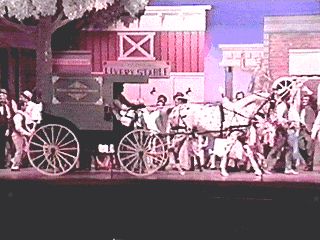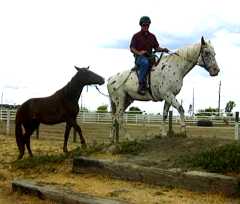Managing Arthritis in Horses"Prints" was diagnosed as being incurably
|
|
GLUCOSOMINE SULFATE and CHONDROITIN SULFATE |
Glucosomine sulfate and chondroitin sulfate are both "over the counter" supplements that can be added to the horse's daily ration. Recent studies in Toronto have shown that Glucosomine Sulfate in particular has resulted in improvement of arthritic joints in clinical studies.
Chondroitin is a natural component of joint cartilage and chondroitin sulfate is believed to block certain enzymes that tend to break down cartilage. While experts disagree on how much chondroitin is actually absorbed when taken orally, preliminary findings suggest that chondroitin supplements are linked to the stabilization and sometimes the functional restoration of certain arthritic joints.
Based on our experience with older arthritic horses, we prefer supplements that combine glucosomine sulfate and chondroitin sulfate.
|
LEGEND (hyaluronate sodium) |
The most remarkable results we have experienced involved the intravenous application of "Legend" injectable solution. Available by prescription, Legend hyaluronate sodium readily converts to hyaluronic acid in the joint. High concentrations of hyaluronic acid are found in synovial fluid, the lubricating liquid of joints. Hyaluronic acid exerts an anti-inflammatory action in the joint. It also appears to regulate normal cellular constituents in a way that decreases enzyme release and degradation of joint integrity. It has no known significant side effects and virtually all of the horses we witnessed that had even relatively advanced arthritis in stable joints showed visible improvement after receiving a series of injections.
Hyaluronic acid is found in certain microorganisms. In Legend, hyaluronic acid is extracted from Streptoccus spp. and is purified to a form that is free of protein and nucleic acids. Since Legend originates from a microbial source, there is no potential for contamination with dermatin, chondroitin sulfate or any other glycosaminoglycan.
In layman's terms Legend is safe to use in conjunction with oral supplements and there are no contraindications listed on the Legend package insert.
Legend is a registered trademark of Bayer Corporation
REFERENCES:
Bayer: Equine Joint Disease Therapy
FDA Clinical Trial
| OUR FIELD EXPERIENCE |
We observed a small number of older arthritic horses, one of which was our own. These animals were suffering from advancing arthritis that had caused sufficient joint degeneration to make the horses unfit for riding. These horses had reached the point where oral supplements were no longer maintaining adequate joint function.
Legend's label recommends that dosages be given at weekly intervals. In these horses we chose to administer Legend injectable on a monthly basis. In most instances the horses started showing signs of improvement within two weeks. By the third month these horses were showing significant improvement and returned to light work. One older mare with an unstable joint did not improve, however in her case the joint damage was significant prior to administering the series of injections.
These horses continued to receive oral supplements of glucosomine sulfate and chondroitin sulfate during the injection series and continuously thereafter. Most of the horses needed a Legend "booster" about 18 months following the initial series.
| PRACTICAL JOINT CARE |
These animals seemed to also benefit from regular controlled exercise. Regular low impact joint movement, such as being turned out to amble and graze, appeared to aid in the reduction of pain and recovery of resistance free joint movement. Overexercise could still result in pain and inflammation, but those instances appeared to be less problematic than before treatment was provided.
As with any orthopedic situation, horses can benefit from certain medications, but common sense and practical use of recovering horses is, in our opinion, equally important.
| SUMMARY NOTES |
What we have learned so far is:
- Practical preventive care (not overstressing the joints,
particularly in young horses) is the most efficient and cost-effective way to avoid
osteoarthritis problems.
- As the horse ages and arthritic changes start to develop,
oral supplements appear to help control arthritic decline.
- As osteoarthritis advances, Legend injectable given
in a series can oftentimes produce visible beneficial results.
- In all cases, sensible exercise and avoiding situations that generated significant stress in arthritic joints appeared to help the condition of these horses.
| As with any prescription medication, the subject horse should be properly diagnosed by a veterinarian before starting therapy using Legend injectable solution. In addition to its osteoarthritic condition, the whole horse, including balance of foot, environment, exercise and diet should be considered in order to produce a rehabilitation program that maximizes the horse's favorable response to the medication being used, and to prolong the horse's comfort and usefulness if its osteoarthritis pain and lameness are to be successfully managed. |
Ponying a young mustang
|
Press Back to return to the page which brought you here
Return to KBR Horse Health Section
Return to KBR Training Section
Go to KBR Safety Section
Return to KBR World of Wild Horses & Burros
Go To  KBR Horse Net
KBR Horse Net
KBR Horse Health Information, © 1997 Lamm's Kickin' Back
Ranch and Willis & Sharon Lamm. All rights reserved. Duplication of any of this material for
commercial use is prohibited without express written permission. This prohibition is
not intended to extend to personal non-commercial use, including sharing with others for
safety and learning purposes, provided this copyright notice is attached.
Email us to submit comments or request reproduction
permission.


